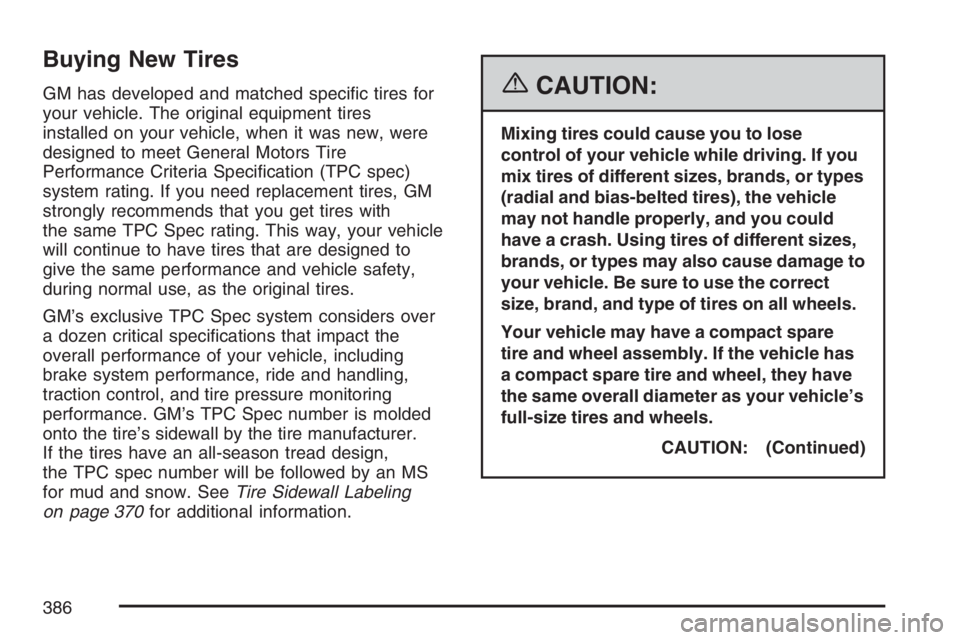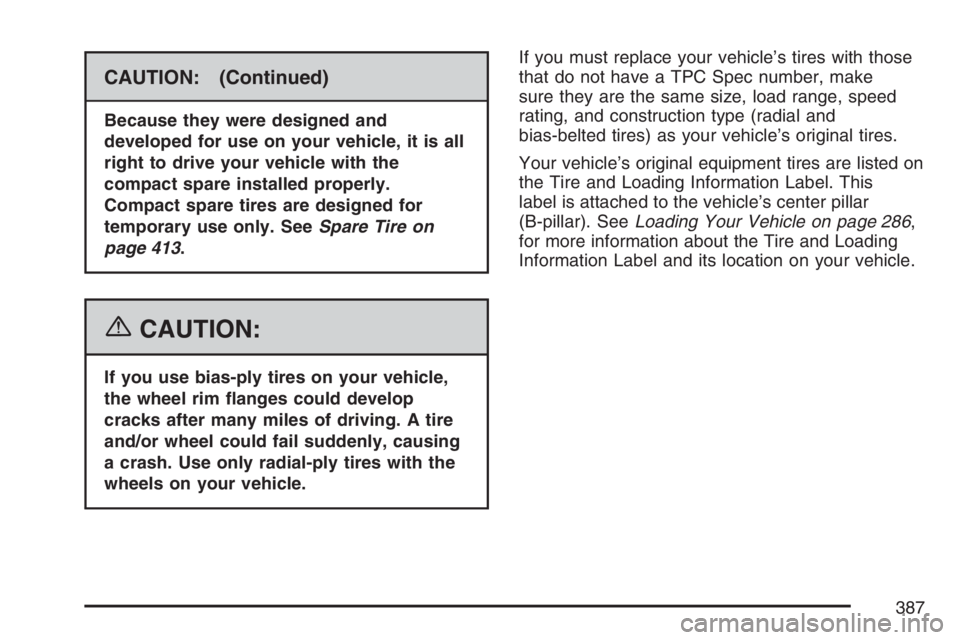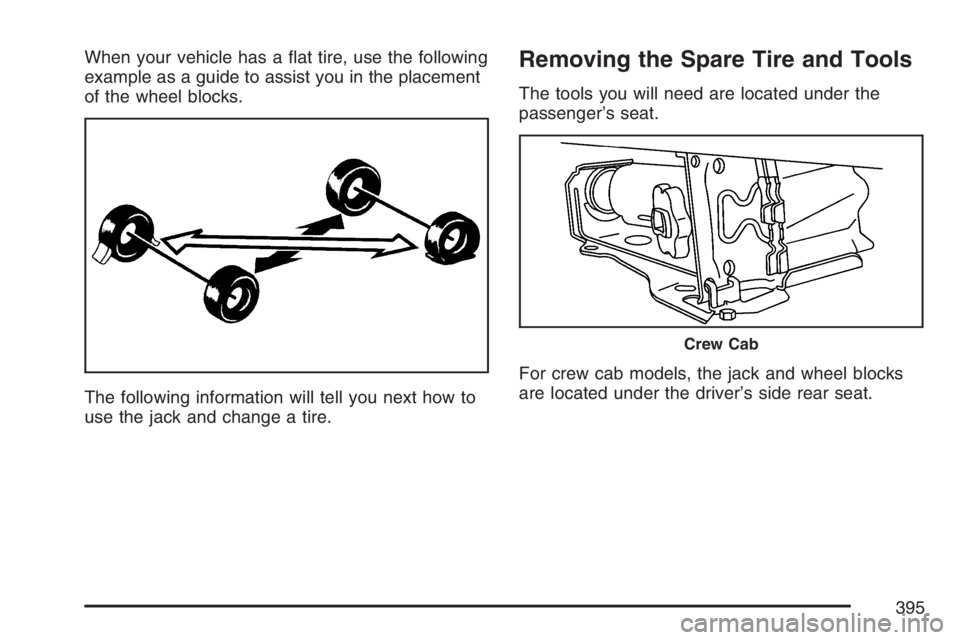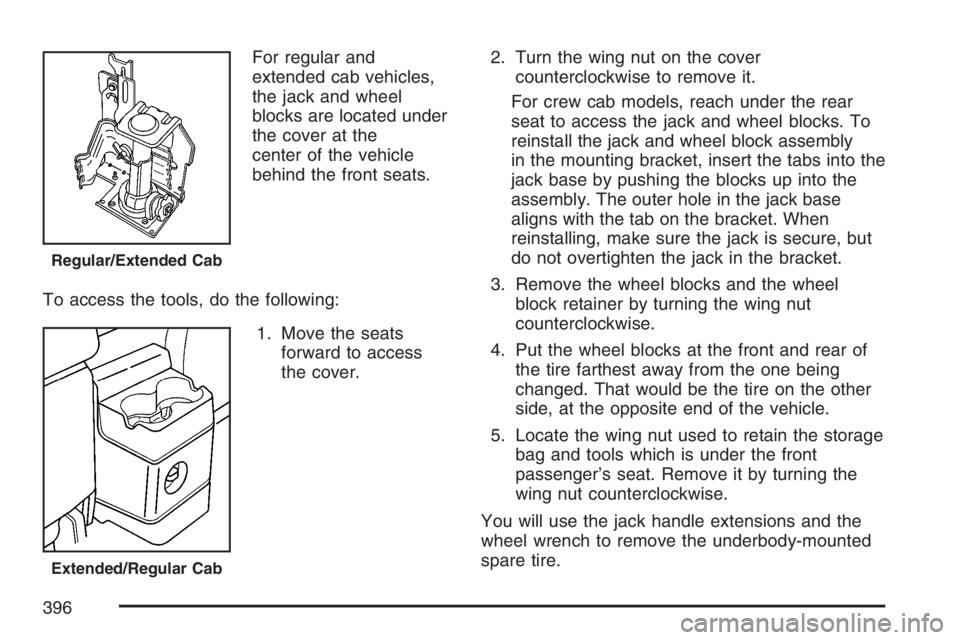2007 GMC CANYON spare tire
[x] Cancel search: spare tirePage 379 of 492

For additional information and details about the
DIC operation and displays seeDIC Controls and
Displays on page 194andDIC Warnings and
Messages on page 198.
You may notice, during cooler weather conditions,
that the low tire pressure warning light and the
DIC LOW TIRE message may come on when the
vehicle is �rst started, and then turn off as you
start to drive. This may be an early indicator that
the air pressure in the tire(s) is getting low
and needs to be in�ated to the proper pressure.
Each tire, including the spare (if provided), should
be checked monthly when cold and in�ated to
the in�ation pressure recommended by the vehicle
manufacturer on the vehicle placard or tire
in�ation pressure label. (If your vehicle has tires of
a different size than the size indicated on the
vehicle placard or tire in�ation pressure label, you
should determine the proper tire in�ation
pressure for those tires.)As an added safety
feature, your vehicle
has been equipped with
a tire pressure
monitoring system
(TPMS) that illuminates
a low tire pressure
telltale when one
or more of your tires is
signi�cantly
under-in�ated.
Accordingly, when the low tire pressure telltale
illuminates, you should stop and check your tires
as soon as possible, and in�ate them to the
proper pressure. Driving on a signi�cantly
under-in�ated tire causes the tire to overheat and
can lead to tire failure. Under-in�ation also
reduces fuel efficiency and tire tread life, and may
affect the vehicle’s handling and stopping ability.
Please note that the TPMS is not a substitute for
proper tire maintenance, and it is the driver’s
responsibility to maintain correct tire pressure, even
if under-in�ation has not reached the level to trigger
illumination of the TPMS low tire pressure telltale.
379
Page 383 of 492

Federal Communications Commission
(FCC) and Industry and Science Canada
The Tire Pressure Monitor System (TPMS)
operates on a radio frequency and complies with
Part 15 of the FCC Rules. Operation is subject
to the following two conditions:
1. This device may not cause harmful
interference.
2. This device must accept any interference
received, including interference that may
cause undesired operation.
The Tire Pressure Monitor System (TPMS)
operates on a radio frequency and complies with
RSS-210 of Industry and Science Canada.
Operation is subject to the following two
conditions:
1. This device may not cause interference.
2. This device must accept any interference
received, including interference that may
cause undesired operation of the device.
Changes or modi�cations to this system by other
than an authorized service facility could void
authorization to use this equipment.
Tire Inspection and Rotation
Tires should be rotated every 5,000 to 8,000 miles
(8 000 to 13 000 km).
Any time you notice unusual wear, rotate your
tires as soon as possible and check wheel
alignment. Also check for damaged tires or wheels.
SeeWhen It Is Time for New Tires on page 385
andWheel Replacement on page 390for
more information.
Make sure the spare tire is stored securely. Push,
pull, and then try to rotate or turn the tire. If it
moves, use the wheel wrench to tighten the cable.
SeeChanging a Flat Tire on page 394.
The purpose of regular rotation is to achieve more
uniform wear for all tires on the vehicle. The
�rst rotation is the most important, seeScheduled
Maintenance on page 437.
383
Page 384 of 492

When rotating your tires, always use one of the
correct rotation patterns shown here.
If your vehicle has a compact spare tire or a spare
tire that does not match your vehicle’s road tires
and wheels, in size and type, do not include
the spare in the tire rotation.
After the tires have been rotated, adjust the front
and rear in�ation pressures as shown on the
Tire and Loading Information label. For the location
of the Tire and Loading Information label see
Loading Your Vehicle on page 286. Make certain
that all wheel nuts are properly tightened, see
“Wheel Nut Torque” underCapacities and
Speci�cations on page 430for the proper wheel
nut torque speci�cation.
{CAUTION:
Rust or dirt on a wheel, or on the parts to
which it is fastened, can make wheel nuts
become loose after time. The wheel could
come off and cause an accident. When
you change a wheel, remove any rust or
dirt from places where the wheel attaches
to the vehicle. In an emergency, you can
use a cloth or a paper towel to do this;
but be sure to use a scraper or wire brush
later, if needed, to get all the rust or dirt
off. SeeChanging a Flat Tire on page 394.
Any time you rotate the vehicle’s tires the Tire
Pressure Monitor System (TPMS) will need to be
reset. The TPMS identi�cation codes will need
to be matched to the tire and wheel position. See
“TPMS Sensor Identi�cation Codes” underTire
Pressure Monitor System on page 378.
384
Page 386 of 492

Buying New Tires
GM has developed and matched speci�c tires for
your vehicle. The original equipment tires
installed on your vehicle, when it was new, were
designed to meet General Motors Tire
Performance Criteria Speci�cation (TPC spec)
system rating. If you need replacement tires, GM
strongly recommends that you get tires with
the same TPC Spec rating. This way, your vehicle
will continue to have tires that are designed to
give the same performance and vehicle safety,
during normal use, as the original tires.
GM’s exclusive TPC Spec system considers over
a dozen critical speci�cations that impact the
overall performance of your vehicle, including
brake system performance, ride and handling,
traction control, and tire pressure monitoring
performance. GM’s TPC Spec number is molded
onto the tire’s sidewall by the tire manufacturer.
If the tires have an all-season tread design,
the TPC spec number will be followed by an MS
for mud and snow. SeeTire Sidewall Labeling
on page 370for additional information.{CAUTION:
Mixing tires could cause you to lose
control of your vehicle while driving. If you
mix tires of different sizes, brands, or types
(radial and bias-belted tires), the vehicle
may not handle properly, and you could
have a crash. Using tires of different sizes,
brands, or types may also cause damage to
your vehicle. Be sure to use the correct
size, brand, and type of tires on all wheels.
Your vehicle may have a compact spare
tire and wheel assembly. If the vehicle has
a compact spare tire and wheel, they have
the same overall diameter as your vehicle’s
full-size tires and wheels.
CAUTION: (Continued)
386
Page 387 of 492

CAUTION: (Continued)
Because they were designed and
developed for use on your vehicle, it is all
right to drive your vehicle with the
compact spare installed properly.
Compact spare tires are designed for
temporary use only. SeeSpare Tire on
page 413.
{CAUTION:
If you use bias-ply tires on your vehicle,
the wheel rim �anges could develop
cracks after many miles of driving. A tire
and/or wheel could fail suddenly, causing
a crash. Use only radial-ply tires with the
wheels on your vehicle.If you must replace your vehicle’s tires with those
that do not have a TPC Spec number, make
sure they are the same size, load range, speed
rating, and construction type (radial and
bias-belted tires) as your vehicle’s original tires.
Your vehicle’s original equipment tires are listed on
the Tire and Loading Information Label. This
label is attached to the vehicle’s center pillar
(B-pillar). SeeLoading Your Vehicle on page 286,
for more information about the Tire and Loading
Information Label and its location on your vehicle.
387
Page 389 of 492

Uniform Tire Quality Grading
Quality grades can be found where applicable on
the tire sidewall between tread shoulder and
maximum section width. For example:
Treadwear 200 Traction AA Temperature A
The following information relates to the system
developed by the United States National Highway
Traffic Safety Administration (NHTSA), which
grades tires by treadwear, traction, and
temperature performance. This applies only to
vehicles sold in the United States. The grades are
molded on the sidewalls of most passenger car
tires. The Uniform Tire Quality Grading (UTQG)
system does not apply to deep tread, winter-type
snow tires, space-saver, or temporary use
spare tires, tires with nominal rim diameters of
10 to 12 inches (25 to 30 cm), or to some
limited-production tires.
While the tires available on General Motors
passenger cars and light trucks may vary with
respect to these grades, they must also conform
to federal safety requirements and additional
General Motors Tire Performance Criteria (TPC)
standards.
Treadwear
The treadwear grade is a comparative rating
based on the wear rate of the tire when tested
under controlled conditions on a speci�ed
government test course. For example, a tire
graded 150 would wear one and a half (1.5) times
as well on the government course as a tire
graded 100. The relative performance of tires
depends upon the actual conditions of their use,
however, and may depart signi�cantly from
the norm due to variations in driving habits, service
practices, and differences in road characteristics
and climate.
Traction – AA, A, B, C
The traction grades, from highest to lowest, are
AA, A, B, and C. Those grades represent the tire’s
ability to stop on wet pavement as measured
under controlled conditions on speci�ed
government test surfaces of asphalt and concrete.
A tire marked C may have poor traction
performance.
Warning:The traction grade assigned to this tire
is based on straight-ahead braking traction
tests, and does not include acceleration, cornering,
hydroplaning, or peak traction characteristics.
389
Page 395 of 492

When your vehicle has a �at tire, use the following
example as a guide to assist you in the placement
of the wheel blocks.
The following information will tell you next how to
use the jack and change a tire.Removing the Spare Tire and Tools
The tools you will need are located under the
passenger’s seat.
For crew cab models, the jack and wheel blocks
are located under the driver’s side rear seat.
Crew Cab
395
Page 396 of 492

For regular and
extended cab vehicles,
the jack and wheel
blocks are located under
the cover at the
center of the vehicle
behind the front seats.
To access the tools, do the following:
1. Move the seats
forward to access
the cover.2. Turn the wing nut on the cover
counterclockwise to remove it.
For crew cab models, reach under the rear
seat to access the jack and wheel blocks. To
reinstall the jack and wheel block assembly
in the mounting bracket, insert the tabs into the
jack base by pushing the blocks up into the
assembly. The outer hole in the jack base
aligns with the tab on the bracket. When
reinstalling, make sure the jack is secure, but
do not overtighten the jack in the bracket.
3. Remove the wheel blocks and the wheel
block retainer by turning the wing nut
counterclockwise.
4. Put the wheel blocks at the front and rear of
the tire farthest away from the one being
changed. That would be the tire on the other
side, at the opposite end of the vehicle.
5. Locate the wing nut used to retain the storage
bag and tools which is under the front
passenger’s seat. Remove it by turning the
wing nut counterclockwise.
You will use the jack handle extensions and the
wheel wrench to remove the underbody-mounted
spare tire.
Regular/Extended Cab
Extended/Regular Cab
396